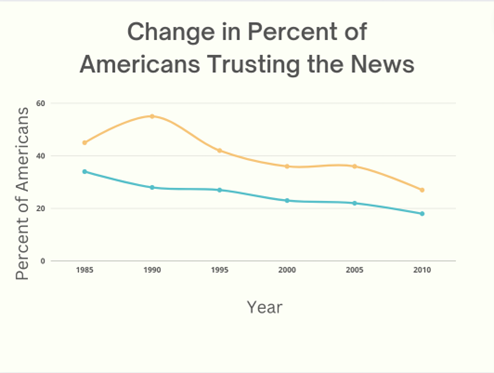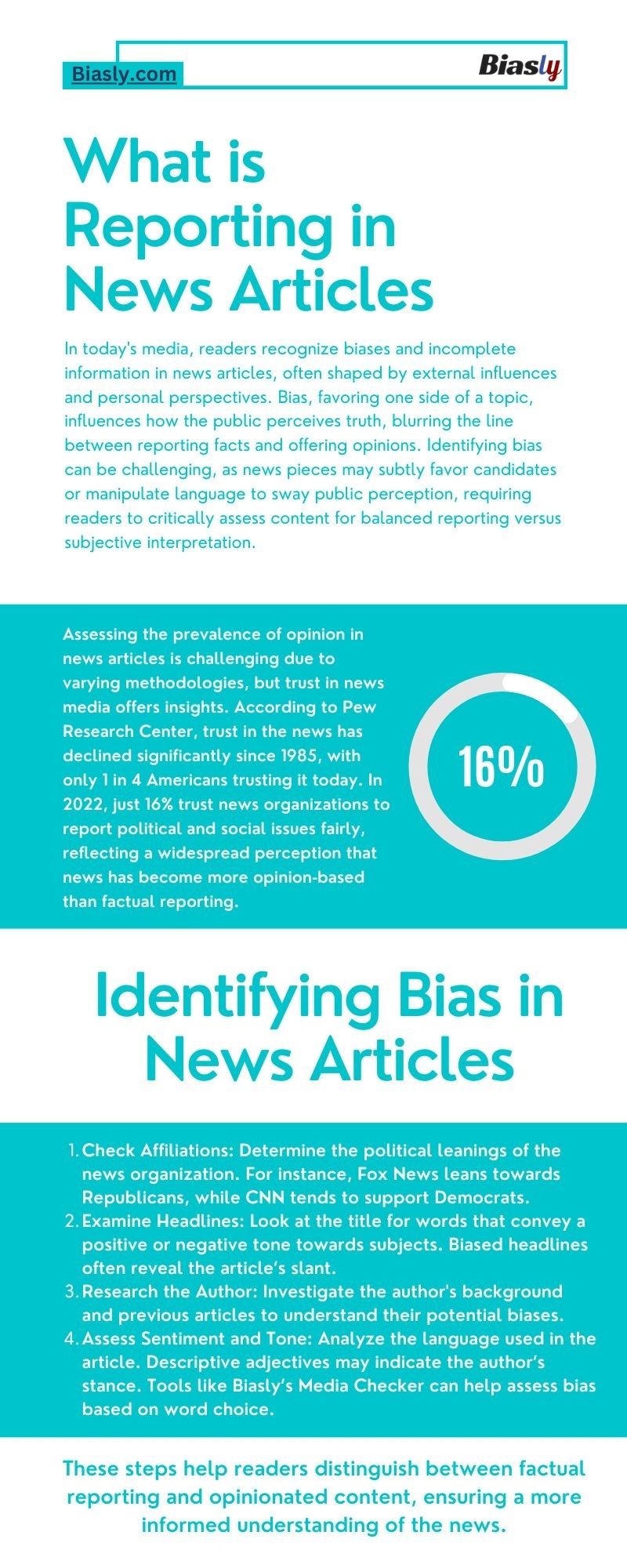
Many people are aware that the news articles that they read contain biases and often incomplete and one-sided facts. There are external factors and personal experiences that influence the author to favor a particular stance. That favoring of one stance on a topic is called bias, however, readers may feel that they are good at identifying bias when they come across it.
However, in the modern era, authors and news organizations have been clever with the way they implement bias in their articles. This has massive effects on how the public perceives the truth. The focus of this article is to identify the fine line between reporting and bias and understand how to identify bias.
By definition, the word “opinion” means “a view or judgment formed about something, not necessarily based on fact or knowledge”. Reporting by definition means “giving a spoken or written account of something that one has observed, heard, done or investigated”. Although the definitions of these two words are very different, the line between opinion and reporting is thin.
When readers try to identify if something is an opinion or a statement of reporting, it may be confusing because there is such a thin line between them. For example, an author might be reporting on the 2024 presidential election, providing valuable statistics on the turnout rate in each state, however, the reporter’s word choice for each presidential candidate might favor one over the other. Another example might be a news platform that portrays a candidate as slightly losing so viewers will get out and vote.
How Often Does Opinion in News Articles Occur
Calculating opinion in news articles is hard to measure since everyone has their own methodology for assessing bias; however, statistics on viewers’ trust in news websites can provide insight into the reliability of certain news sources. According to Pew Research Center for the People and the press, 55% of Americans trusted the news media in 1985 but only 1 in four Americans trust the news media today. During that same year, 34% of Americans trusted news organizations to be fair in reporting political and social issues but only 16% trusted it to be fair in 2022. Scholars might feel conflicted about how biased the media truly is however the general public believes that news these days is primarily opinion-based rather than reporting.

Source: Pew Research
Disclaimer: Pew Research Center bears no responsibility for the analyses or interpretations of the data presented here. The opinions expressed herein, including any implications for policy, are those of the author and not of Pew Research Center.
How to know if an article is reporting with opinion
Before diving too deep into how to figure out facts versus mere opinion, let’s take a look at the chart below. The chart shows the political bias of several news organizations based on what they report and its accuracy. News organizations such as CNN and MSNBC tend to be the most left-leaning while Fox and Breitbart tend to be the most right-leaning. BBC and Reuters are considered to be the most neutral.
There are 4 main steps a reader can take in order to check the amount of bias present in the article. These steps give the reader an idea of what personal viewpoints the author may have put in the article and key signals that will help identify those viewpoints.
Step 1: Checking Affiliations
Building from this, the very first step to identifying whether news sources contain biases in articles is to check the political affiliations of the news organization. This is a very good indicator to tell the bias in the article. Sources such as Fox will tend to support the Republicans while sources such as CNN will support the Democrats.
Step 2: Checking Headlines
The second step in identifying true reporting is to look at the title of the article. If the article contains words that describe someone or something in a positive or negative light, chances are that the article could be an opinionated piece. Taking a look at the headline of a Fox news video stating, “Hannity: We know Joe Biden isn’t telling the truth” it is evident that Joe Biden is being portrayed in a negative light. If the title had been labeled something along the lines of “Unanswered questions from White House” then the piece would have been less biased.
Taking a look at an example from the New York Times which leans toward the Democratic side, an article with the title “Trump’s Company Is Guilty of Tax Fraud, a Blow to the Firm and the Man” is also very clear Trump is being portrayed as someone who commits tax fraud often. The second part of the title “a Blow to the Firm and the Man” adds repetitive information to show Trump’s reputation as degrading in the public eye. The article would have been perfectly fine titled, “Trump’s Company was found Guilty of Tax Fraud” without the second part. This just goes to show that biased news organizations tend to display their own thoughts, without any concrete evidence, in the article itself.
As a reader, it is vital to see the wording and adjectives in the title so potential bias can be spotted and avoid fake reporting. Reuters, as mentioned before, has minimal bias. Taking a look at the article titled, “ President Biden signs marriage equality into federal law” it is clear no bias is shown in the article. This is a good indicator that the article has little to no bias thus indicating that this is factual reporting.
Step 3: Checking the Author
The third step is to do background research on the author of the article. This way, the author’s bias through previous articles can be spotted which can highlight their potential viewpoints. This can give insight into how the article the reader is currently reading can have bias.
For example, an article by Fox News titled, “Poll shows Biden’s low level of support in 2024 among Democratic primary voters”, seems like it could have a conservative-leaning, but to be sure, we can look further into the author and previous articles that they have written to see if we can spot any trends. Digging further, the author, Aubrie Spady, tends to lean right based on previous articles. Readers should always make sure to look at other articles the author has written to get an idea of the stance of the author.
Let’s take a look at an example from the other side of the political spectrum. This CNN article named, “How Trump’s legacy became ‘pure poison’ for independents”, whose author is Ronald Brownstein. Once again, a quick google search shows past articles by Brownstein, and once again, it shows that he consistently favors the Democrats.
An NPR article titled,” Unpacking the Biden administration’s approach to China” by Emily Feng shows less bias in the article and her previous articles do not show as much bias to any particular side. Being a reader, try to see the extra words put into the title that shows an opinion of the author. If there is not any, that is a good sign the article is truly a factual piece.
Step 4: Checking the Sentiment and Tone
The last step a reader should take to identify bias is to check the sentiment and tone of the article. This means the word choice the author uses to describe something or someone in a positive or negative light. For example, “The judge gave the defendant a three-year sentence” seems unbiased but when extra words are added to impose the author’s viewpoint on the topic matter, the tone and sentiment of the author are revealed. The sentence “the cruel and irritating judge gave the defendant a three-year sentence” shows that the author clearly dislikes the judge because of the words “cruel” and “irritating”. The sentiment and tone of the author are relatively easy to spot so stay on the lookout for descriptive adjectives that show the author’s stance. One of the easiest ways to check for the author’s tone and sentiment is to use an online bias checker such as Biasly’s Media Checker. This checker scans for the author’s word choice and gives a bias rating based on the article’s political views.
Takeaways
Applying these three steps to every article will truly help to identify what is considered reporting and what is considered biased. Taking 5 minutes to do these three steps can help the reader see more clearly what they are reading. Once again, the three steps are:
- To check the news source rating
- Review the title of the article for bias
- Research the author of the article
- Checking the Sentiment and Tone
The real question the reader needs to ask is not what is the truth, but rather where is bias. Our free Media Bias Checker can help you do this on a more detailed level.























